Analysis of the Temperature Characteristics of Three-Phase Coaxial Superconducting Power Cable according to a Liquid Nitrogen Circulation Method for Real-Grid Application in Korea
Abstract
:1. Introduction
2. Total System and Configuration of Three-Phase Coaxial Superconducting Power Cable
3. Cooling Circulation Structure of Three-Phase Coaxial Superconducting Power Cable
4. Temperature Analysis of Three-Phase Coaxial Superconducting Power Cable Using FEM Modeling
5. Simulation Results
6. Simulation Results Verification
7. Conclusions
Author Contributions
Funding
Conflicts of Interest
References
- Ivanov, Y.; Radovinsky, A.; Zhukovsky, A.; Sasaki, A.; Watanabe, H.; Kawahara, T.; Yamaguchi, S. A compact cooling system for HTS power cable based on thermal siphon for circulation of LN2. In Proceedings of the American Institute of Physics, CP1218, Advances in Cryogenic Engineering: Transactions of the Cryogenic Engineering Conferende—CEC, Tucson, AZ, USA, 28 June–2 July 2010; pp. 865–870. [Google Scholar]
- Demko, J.A. Experimental study of counterflow cooling using a test loop to simulate the thermal characteristics of a hts cable system. In Proceedings of the American Institute of Physics, CP1413, Advances in Cryogenic Engineering: Transactions of the Cryogenic Engineering Conferende—CEC, Spokane, WA, USA, 13–17 June 2012; pp. 283–290. [Google Scholar]
- Demko, J.A.; Duckworth, R.C.; Gouge, M.J.; Knoll, D. Heat transfer experiments and analysis of a simulated hts cable. In Proceedings of the American Institute of Physics, CP1218, Advances in Cryogenic Engineering: Transactions of the Cryogenic Engineering Conferende—CEC, Tucson, AZ, USA, 28 June–2 July 2010; pp. 429–436. [Google Scholar]
- Furuse, M.; Fuchino, S. Analysis and Measurement of Thermal Conductivity of Polypropylene Laminated Paper Impregnated with Subcooled Liquid Nitrogen; Elsevier: Cryogenics, Amsterdam, The Netherlands, 2014. [Google Scholar]
- Shuichiro, F.; Mitsuho, F.; Noboru, H. Longitudinal Temperature Distribution in Superconducting Power Cables with Counter-Flow Cooling. IEEE Trans. Appl. Supercond. 2002, 12, 1339–1342. [Google Scholar]
- Demko, J.A.; Sauers, I.; James, D.R.; Gouge, M.J.; Lindsay, D.; Roden, M.; Tolbert, J.; Willén, D.; Træholt, C.; Nielsen, C.T. Triaxial HTS Cable for the AEP Bixby Project. IEEE Trans. Appl. Supercond. 2007, 17, 2047–2050. [Google Scholar] [CrossRef]
- Chang, H.; Ryu, K.N.; Suk, H. Cryogenic Design of Liquid-Nitrogen Circulation System for Long-Length HTS Cables with Altitude Variation; Elsevier: Amsterdam, The Netherlands, 2017. [Google Scholar]
- Maguire, J.F.; Schmidt, F.; Bratt, S.; Welsh, T.E.; Yuan, J.; Allais, A.; Hamber, F. Development and Demonstration of a HTS Power Cable to Operate in the Long Island Power Authority Transmission Grid. IEEE Trans. Appl. Supercond. 2007, 17, 2034–2037. [Google Scholar] [CrossRef]
- Fisher, P.W.; Cole, M.J.; Demko, J.A.; Foster, C.A.; Gouge, M.J.; Grabovickic, R.W.; Lue, J.W.; Stovall, J.P.; Lindsay, D.T.; Roden, M.L.; et al. Design, Analysis, and Fabrication of a Tri-Axial Cable System. IEEE Trans. Appl. Supercond. 2003, 13, 1938–1941. [Google Scholar] [CrossRef]
- Dondapati, R.S.; Rao, V.V. Pressure Drop and Heat Transfer Analysis of Long Length Internally Cooled HTS Cables. IEEE Trans. Appl. Supercond. 2013, 23, 5400604. [Google Scholar] [CrossRef]
- Kottonau, D.; de Sousa, W.T.B.; Bock, J.; Noe, M. Design Comparisons of Concentric Three-phase HTS Cables. IEEE Trans. Appl. Supercond. 2019, 29. [Google Scholar] [CrossRef]
- Morgan, G.; Jensen, J.E. Counter-flow cooling of a transmission line by supercritical helium. Cryogenics 1977, 17, 259–267. [Google Scholar] [CrossRef]
- Demko, J.; Lue, J.; Gouge, M.; Stovall, J.; Butterworth, Z.; Sinha, U.; Hughey, R. Practical AC loss and thermal considerations for HTS power transmission cable system. IEEE Trans. Appl. Supercon. 2001, 11, 1789–1792. [Google Scholar] [CrossRef]
- Edney, K.; Fox, M.; Gilbert, G. Longitudinal temperature distribution in low temperature cables with counterflow cooling. Cryogenics 1967, 7, 355–358. [Google Scholar] [CrossRef]
- Weedy, B.M.; Rigby, S.J. Thermal and electrical assessment of flexible cryoresistive cables. Cryogenics 1977, 17, 453–459. [Google Scholar] [CrossRef]
- Demko, J.; Lue, J.; Gouge, M.; Fisher, P.; Lindsay, D.; Roden, M. Analysis of a Liquid Nitrogen Cooled Tri-Axial High Temperature Superconducting Cable System. Adv. Cryog. Eng. 2004, 49A, 913–920. [Google Scholar]
- Demko, J.; Duckworth, R. Cooling Configuration Design Considerations for Long-Length HTS Cables. IEEE Trans. Appl. Supercon. 2009, 19, 1752–1755. [Google Scholar] [CrossRef]
- Yang, L.; Yahui, L.; Guoqing, L.; Dongbo, Z.; Chen, C. Two-stage multi-objective OPF for AC/DC grids with VSC-HVDC: Incorporating decisions analysis into optimization. Energy 2018, 147, 286–296. [Google Scholar]
- Mark, S.; Kai, A.; Frank, M.; Torsten, K.; Friedhelm, H.; Thomas, K.; Jean -Maxime, S. Three Years Operation Experience of the Ampacity System Installation in Essen, Germany; EUCAS: Ceneva, Switzerland, 2017. [Google Scholar]
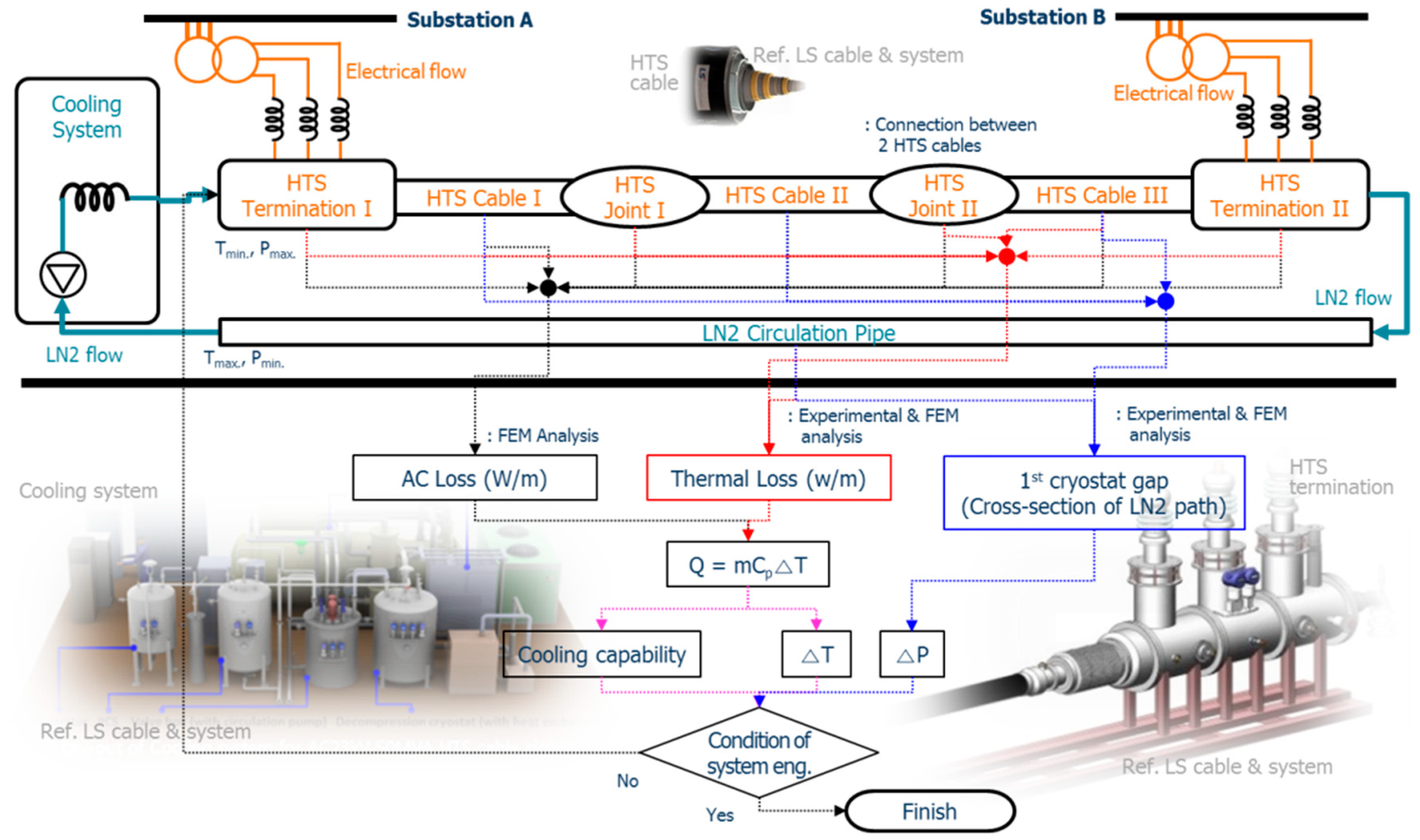
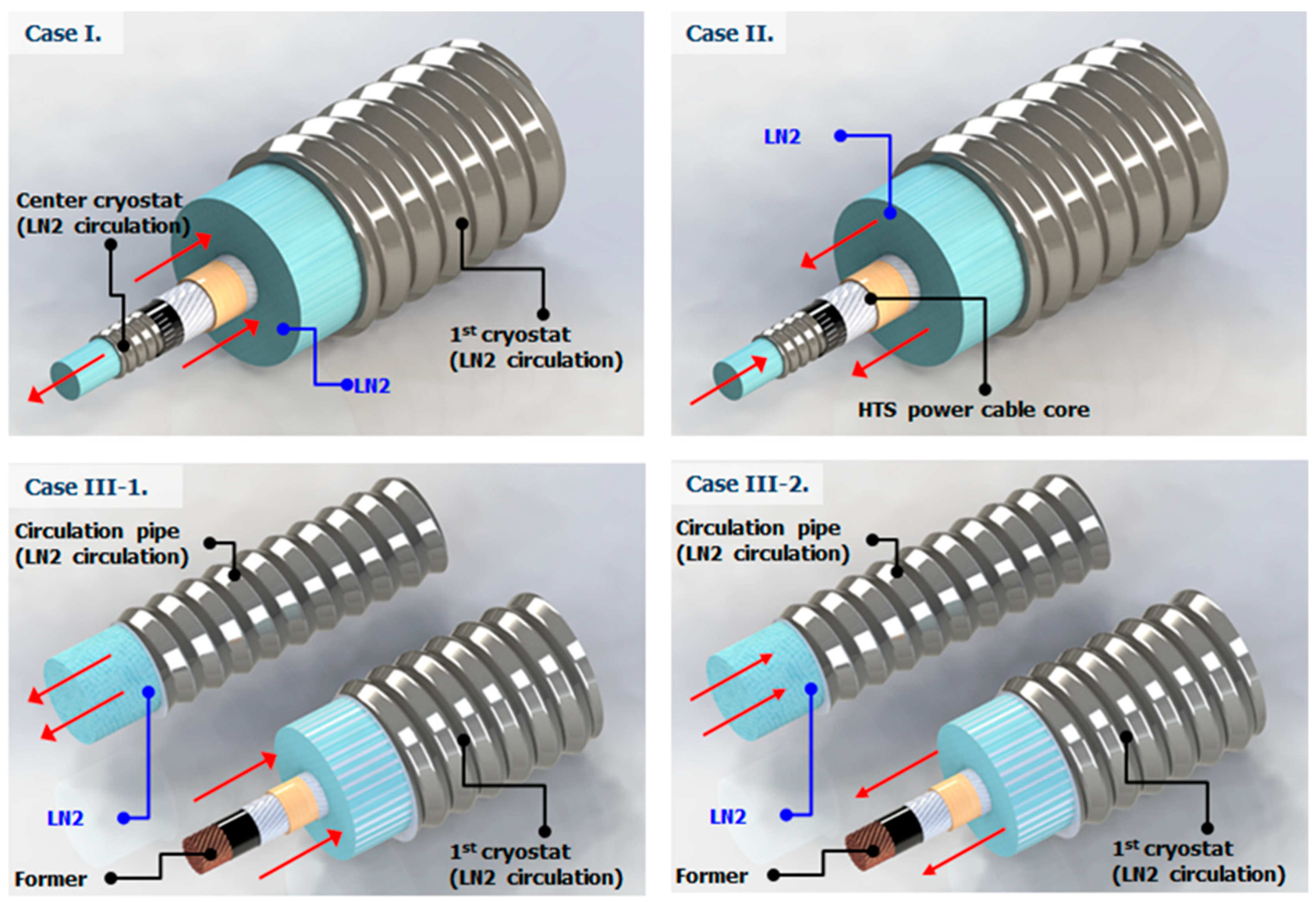
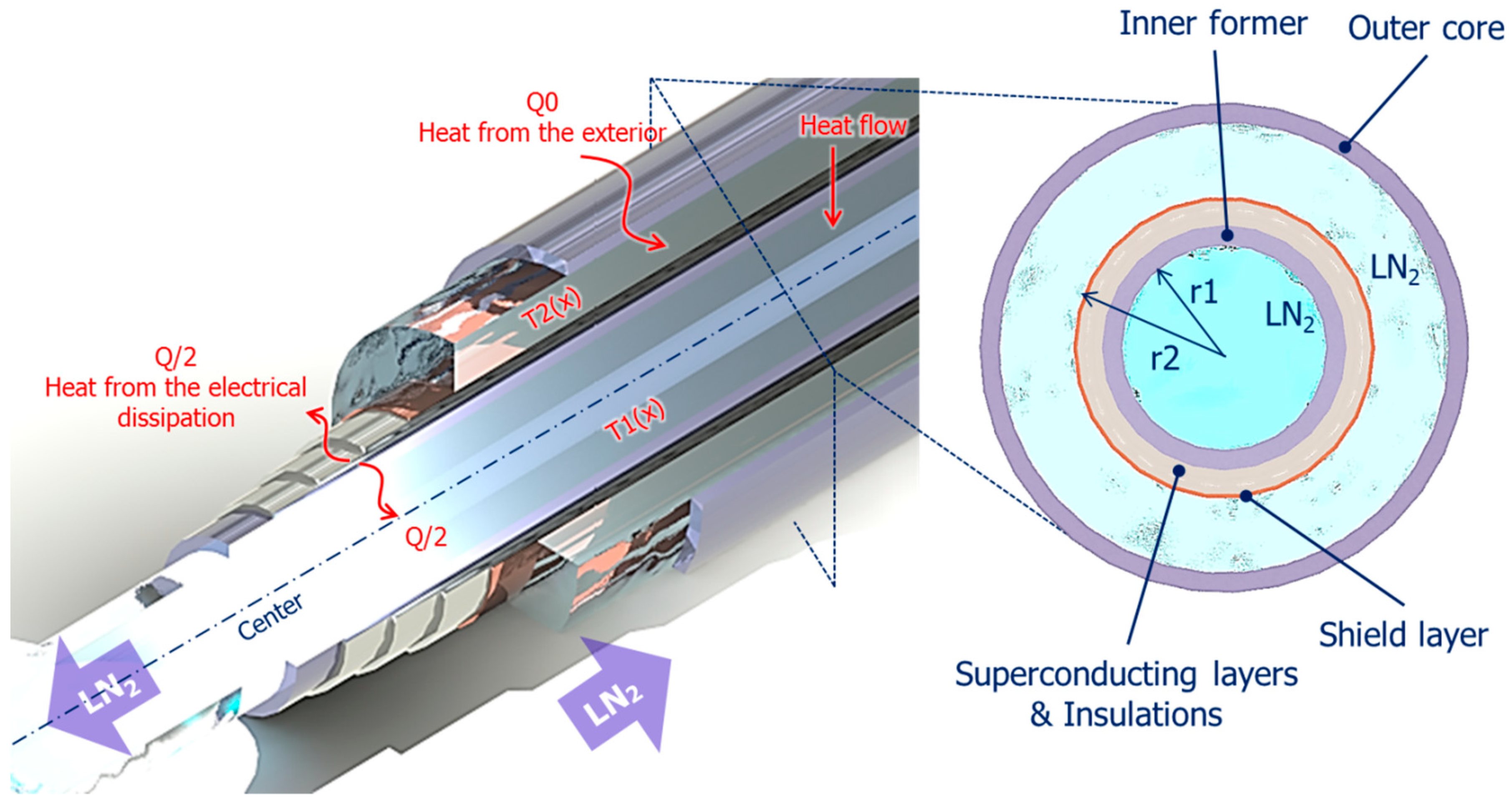
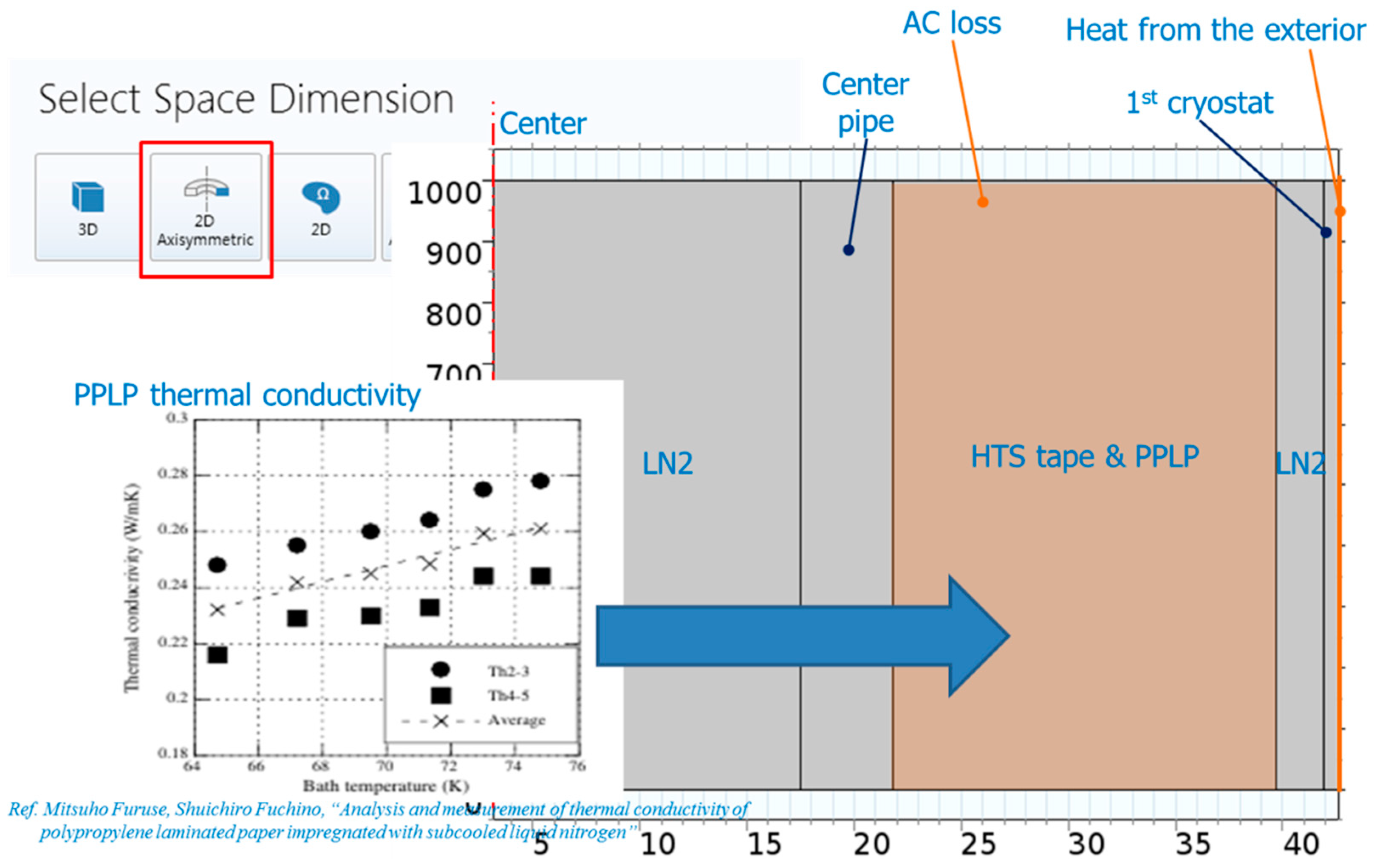
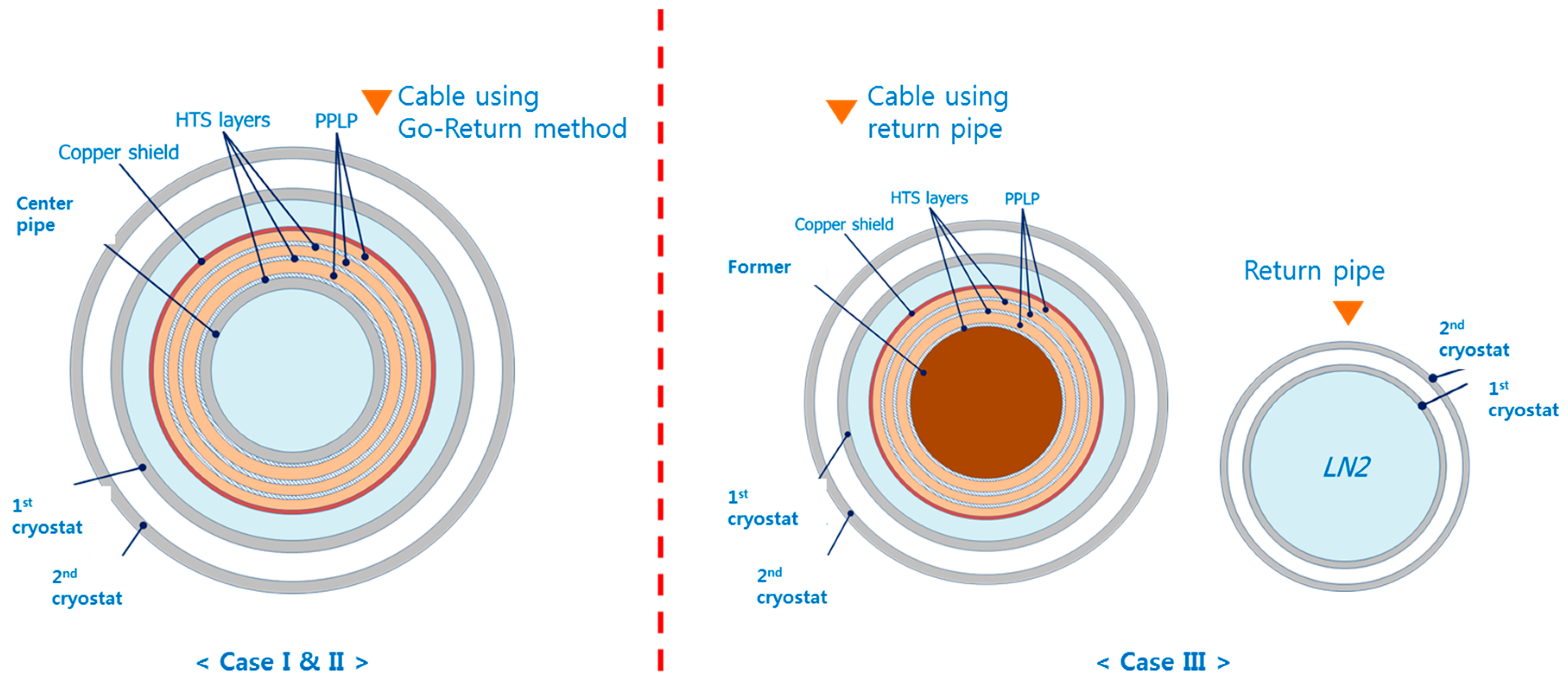
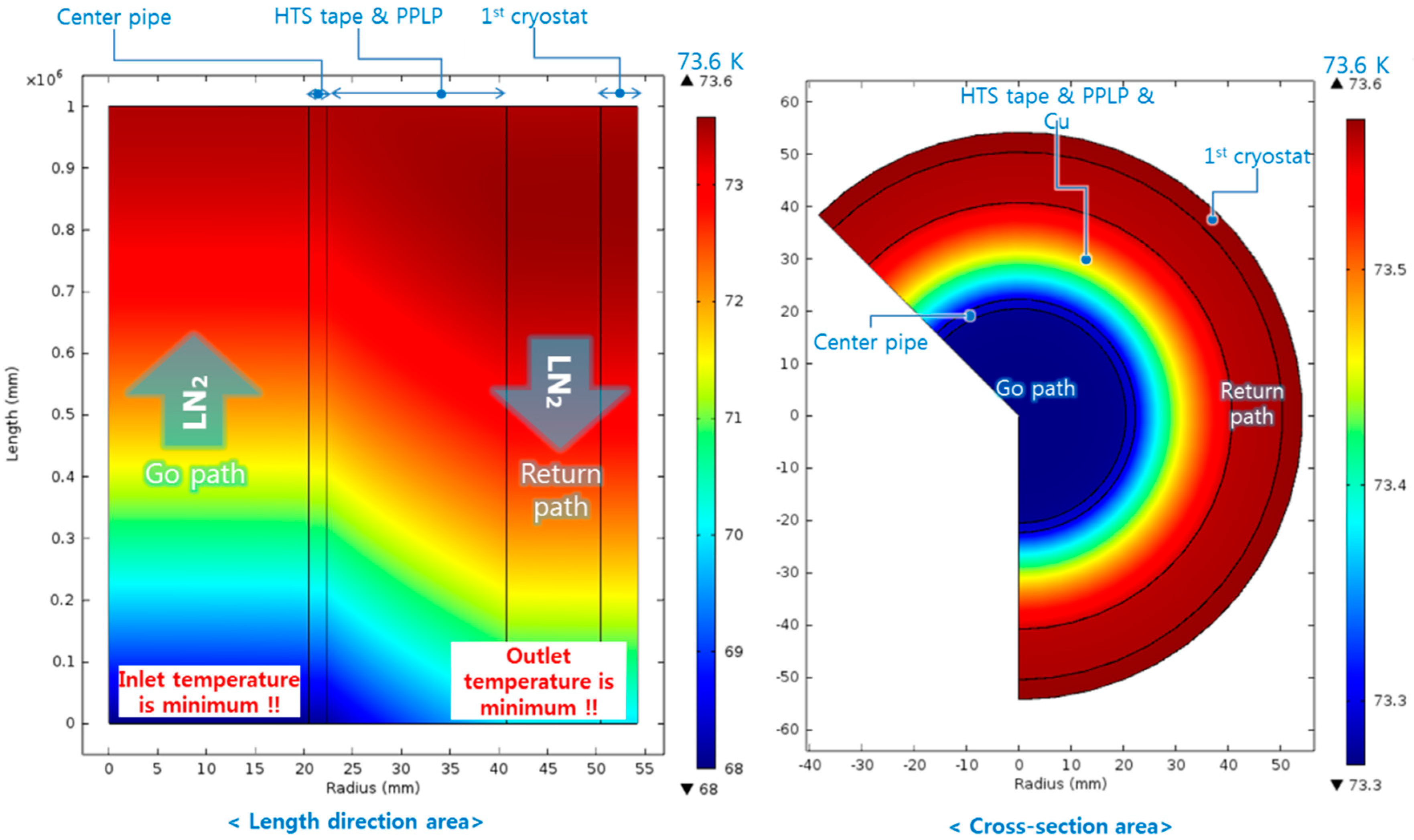
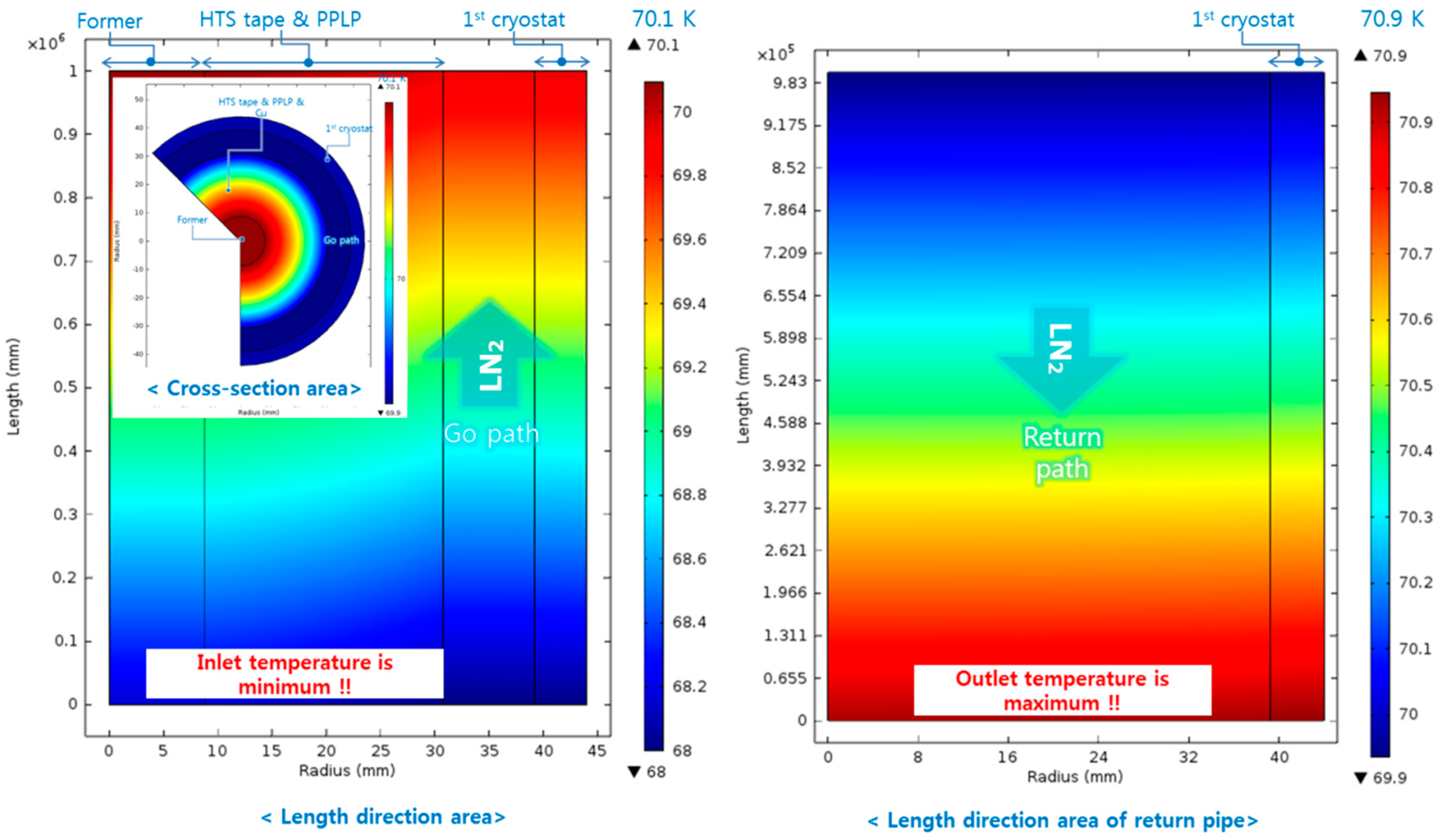
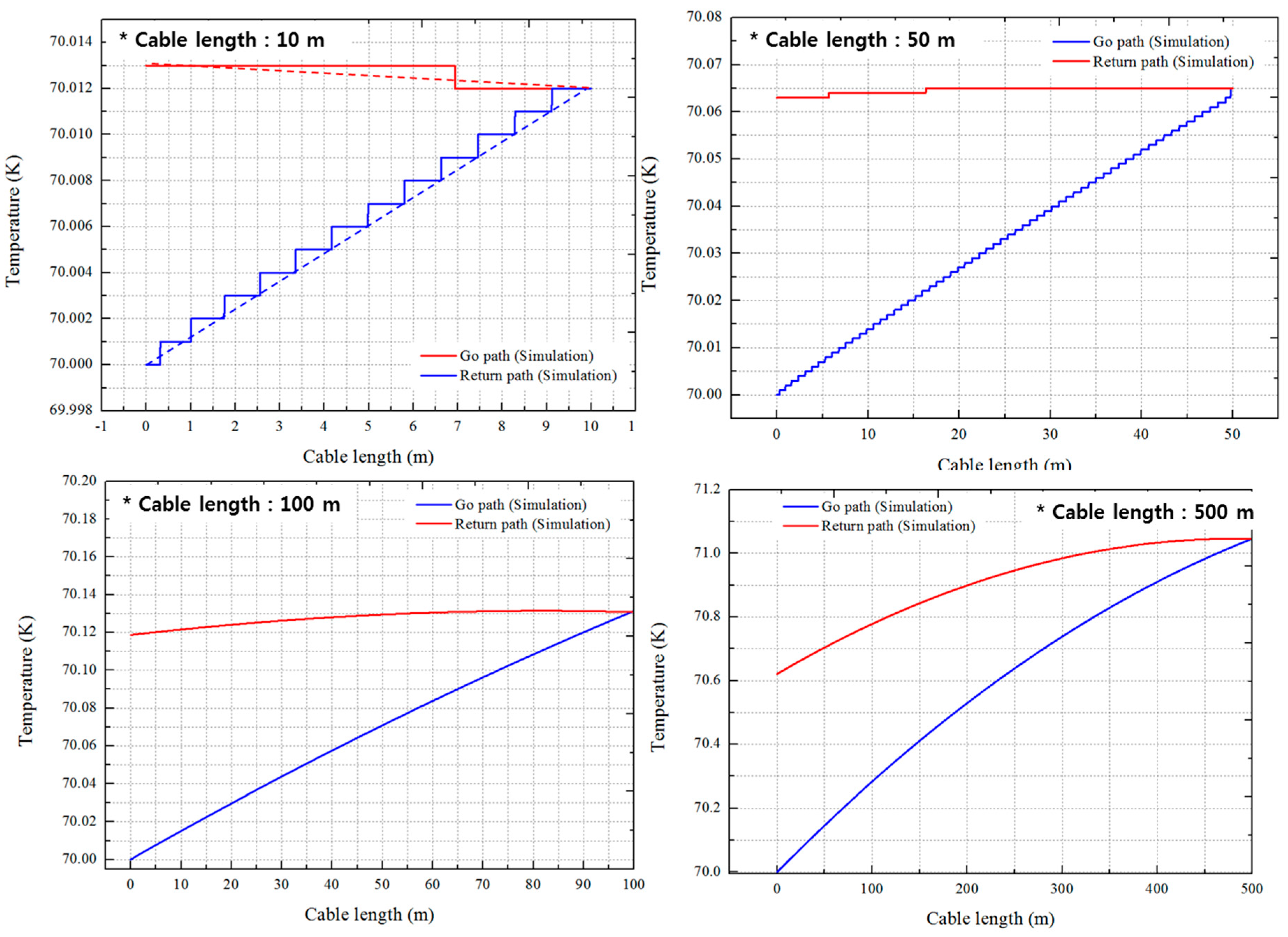
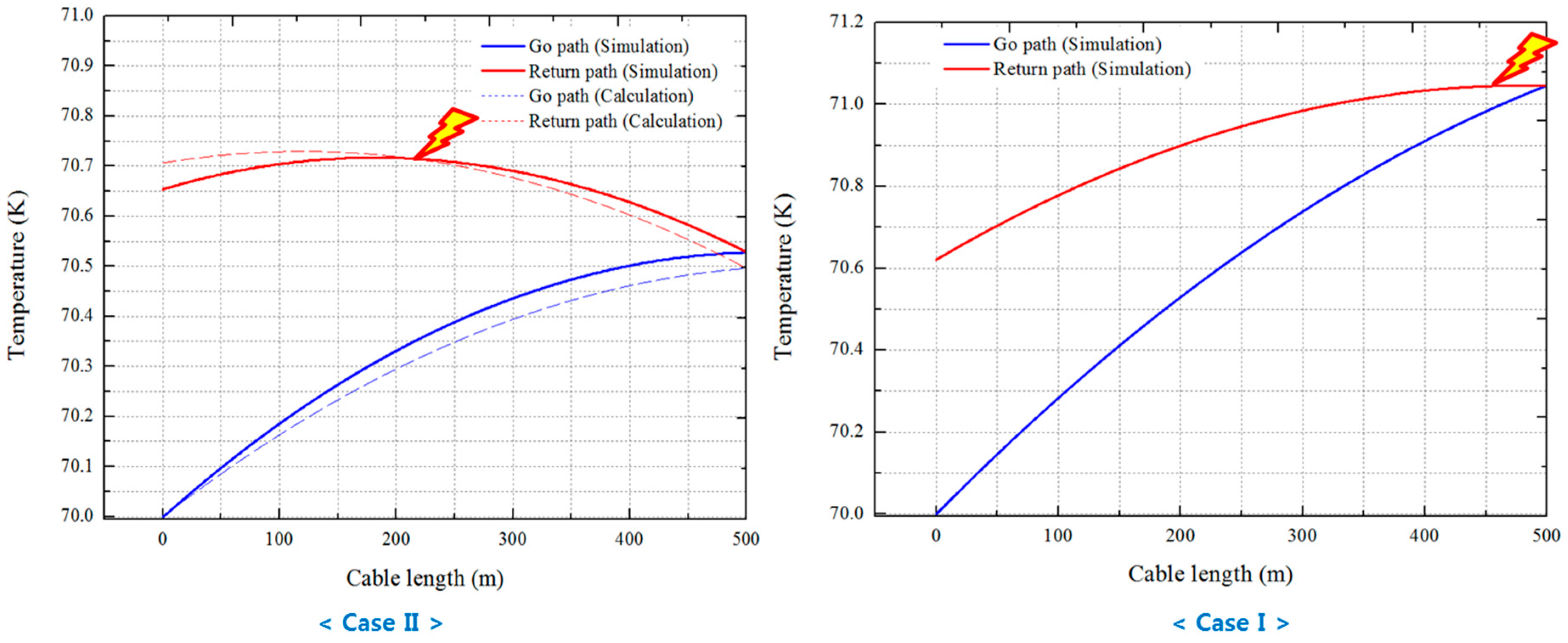
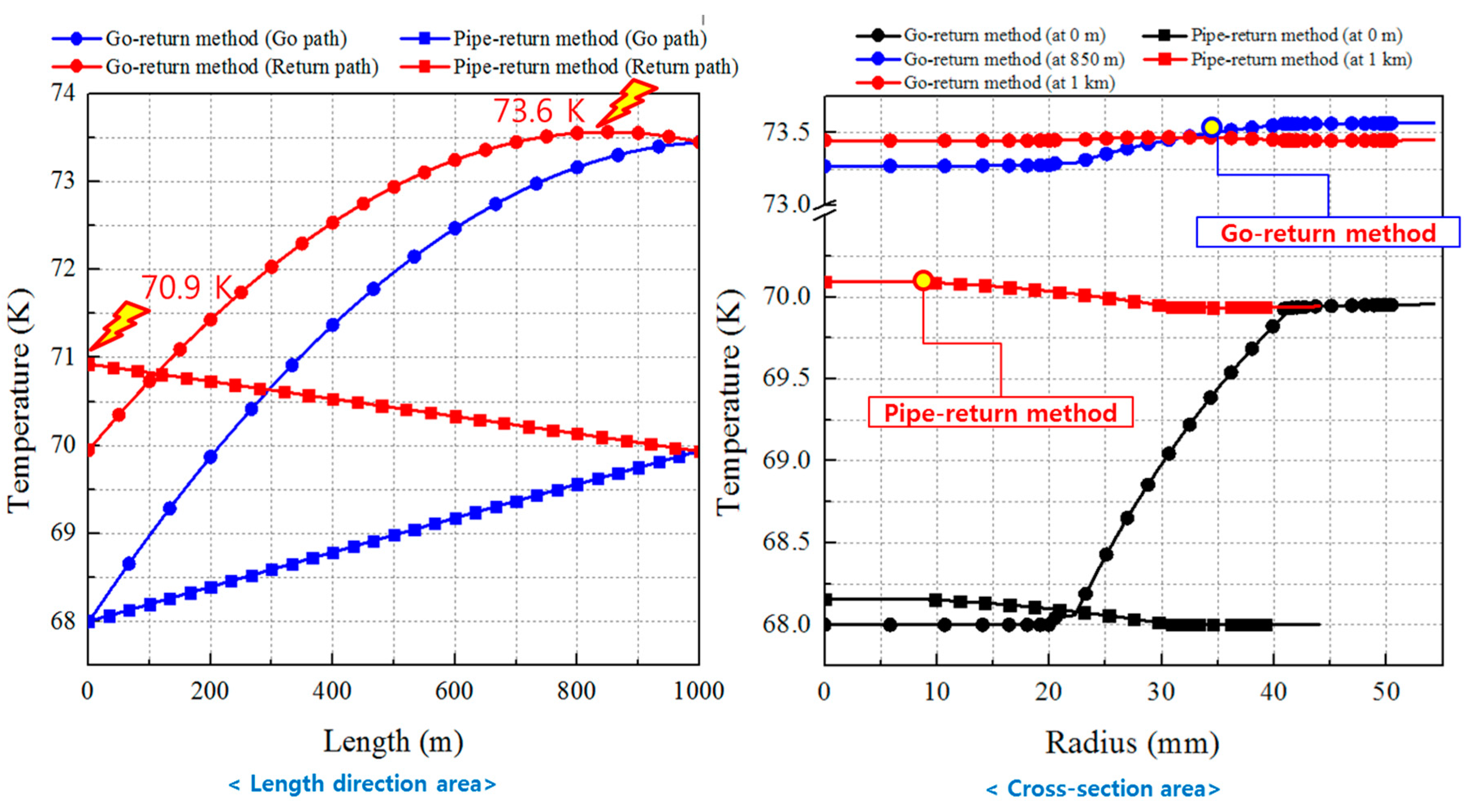
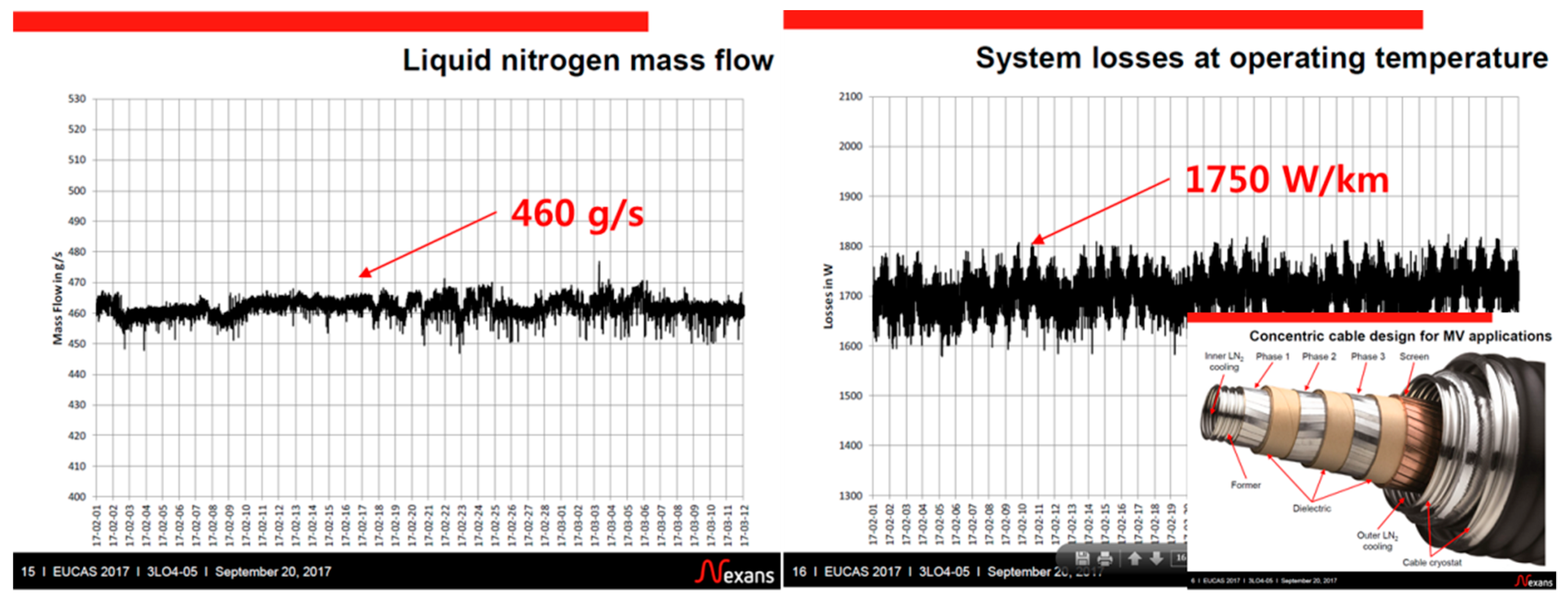
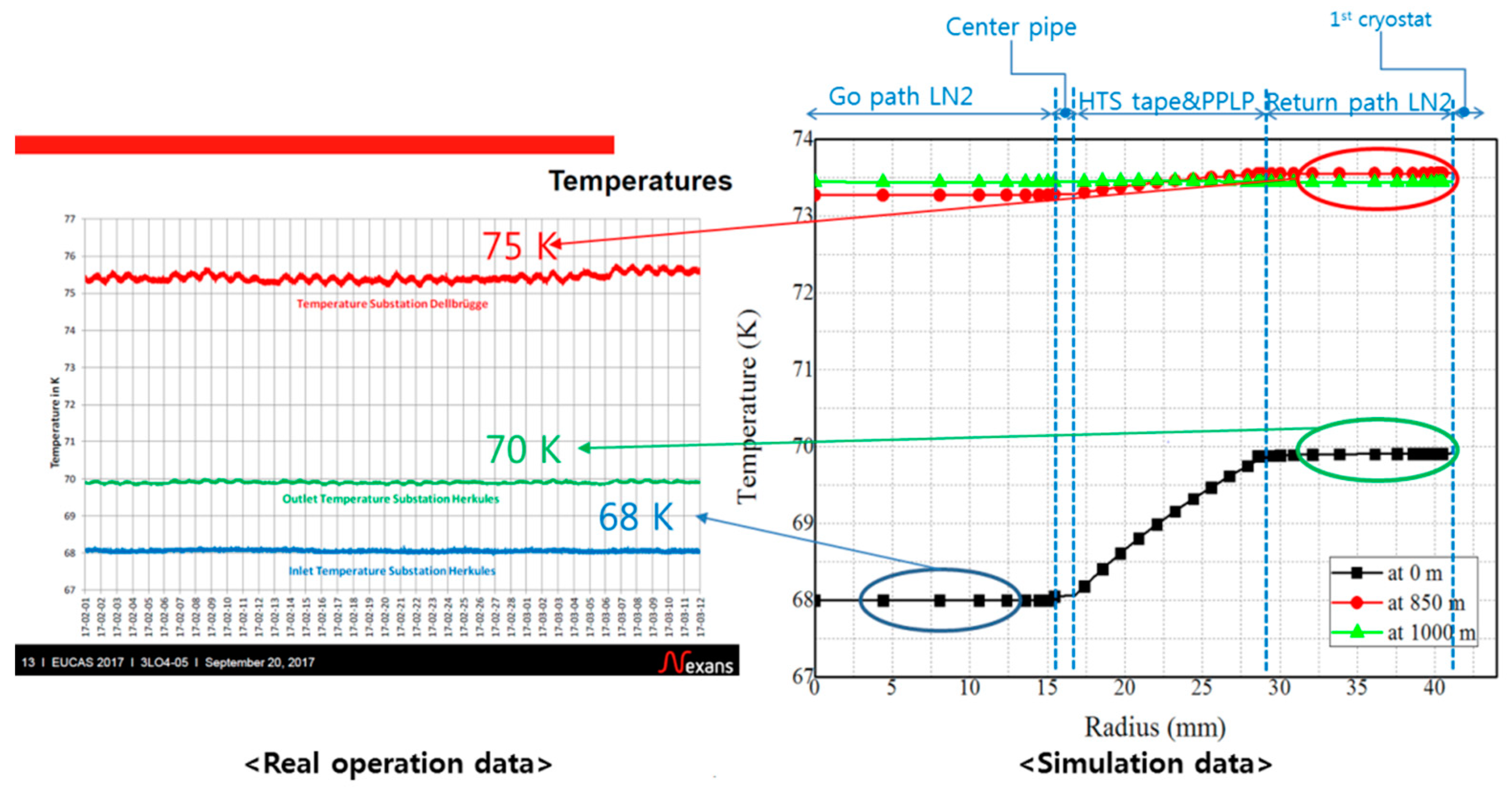
| Cases | LN2 Path Types | Remark |
|---|---|---|
| Case I | 1st cryostat inlet Center pipe outlet | No need for a circulation pipe (one circuit) |
| Case II | Center pipe inlet 1st cryostat outlet | Increase the diameter of the HTS cable (high pressure drop) Uncertain temperature |
| Case III | 1st cryostat inlet Another return pipe outlet | Estimation of max. temperature Need for an extra pipe for the circulation of LN2 (two circuits) |
| Part | Parameter | Value | Unit |
|---|---|---|---|
| Condition of thermal load | Heat from HTS wire (AC loss) | 1 | W/m |
| Heat from the exterior | 1 | W/m | |
| Condition of liquid nitrogen | LN2 temperature of inlet | 68 | K |
| Mass flow | 0.5 | Kg/s | |
| Dynamic viscosity | 1.64 ✕ 10−4 | Pa·s | |
| Heat capacity | 2 | kJ/kg·K |
| Parameter | Value | Remark | ||
|---|---|---|---|---|
| Case I&II | Case III | |||
| Center Pipe | Inner diameter | 40 mm | - | Corrugated tube |
| HTS & Insulation layer | Thickness | About 10 mm | About 12 mm | |
| 1st cryostat | Inner diameter | 100 mm | 80 mm | Corrugated tube |
| Return Pipe | Inner diameter | - | 60 mm | |
| Parameter | Value (Case II) | Remark | |
|---|---|---|---|
| Center Pipe | Inner dia. | 32 mm | Corrugated tube |
| HTS & Insulation layer | Thickness | About 10 mm | |
| 1st cryostat | Inner dia. | 85 mm | Corrugated tube |
| Heat from HTS wire & exterior Mass flow of LN2 | 1.75 W/m | ||
| 0.46 kg/s | |||
© 2019 by the authors. Licensee MDPI, Basel, Switzerland. This article is an open access article distributed under the terms and conditions of the Creative Commons Attribution (CC BY) license (http://creativecommons.org/licenses/by/4.0/).
Share and Cite
Lee, S.-J.; Sung, H.-J.; Park, M.; Won, D.; Yoo, J.; Yang, H.S. Analysis of the Temperature Characteristics of Three-Phase Coaxial Superconducting Power Cable according to a Liquid Nitrogen Circulation Method for Real-Grid Application in Korea. Energies 2019, 12, 1740. https://doi.org/10.3390/en12091740
Lee S-J, Sung H-J, Park M, Won D, Yoo J, Yang HS. Analysis of the Temperature Characteristics of Three-Phase Coaxial Superconducting Power Cable according to a Liquid Nitrogen Circulation Method for Real-Grid Application in Korea. Energies. 2019; 12(9):1740. https://doi.org/10.3390/en12091740
Chicago/Turabian StyleLee, Seok-Ju, Hae-Jin Sung, Minwon Park, DuYean Won, Jaeun Yoo, and Hyung Suk Yang. 2019. "Analysis of the Temperature Characteristics of Three-Phase Coaxial Superconducting Power Cable according to a Liquid Nitrogen Circulation Method for Real-Grid Application in Korea" Energies 12, no. 9: 1740. https://doi.org/10.3390/en12091740
APA StyleLee, S.-J., Sung, H.-J., Park, M., Won, D., Yoo, J., & Yang, H. S. (2019). Analysis of the Temperature Characteristics of Three-Phase Coaxial Superconducting Power Cable according to a Liquid Nitrogen Circulation Method for Real-Grid Application in Korea. Energies, 12(9), 1740. https://doi.org/10.3390/en12091740





